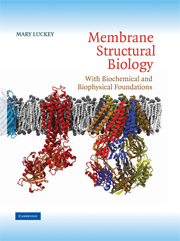Book contents
- Frontmatter
- Contents
- Preface
- 1 Introduction
- 2 The Diversity of Membrane Lipids
- 3 Tools for Studying Membrane Components: Detergents and Model Systems
- 4 Proteins in or at the Bilayer
- 5 Bundles and Barrels
- 6 Functions and Families
- 7 Protein Folding and Biogenesis
- 8 Diffraction and Simulation
- 9 Membrane Enzymes and Transducers
- 10 Transporters and Channels
- 11 Membrane Protein Assemblies
- 12 Themes and Future Directions
- Appendix I Abbreviations
- Appendix II Single-Letter Codes for Amino Acids
- Index
- References
6 - Functions and Families
- Frontmatter
- Contents
- Preface
- 1 Introduction
- 2 The Diversity of Membrane Lipids
- 3 Tools for Studying Membrane Components: Detergents and Model Systems
- 4 Proteins in or at the Bilayer
- 5 Bundles and Barrels
- 6 Functions and Families
- 7 Protein Folding and Biogenesis
- 8 Diffraction and Simulation
- 9 Membrane Enzymes and Transducers
- 10 Transporters and Channels
- 11 Membrane Protein Assemblies
- 12 Themes and Future Directions
- Appendix I Abbreviations
- Appendix II Single-Letter Codes for Amino Acids
- Index
- References
Summary
The functions of most membrane proteins are traditionally described as enzymes, transporters and channels, and receptors, although the demarcations of these groups are blurred. For example, ATPases that are ion channels and other active transport proteins (“permeases”) are studied as enzymes as well as transporters. Some receptors involved in signaling are also tyrosine kinases; other receptors are gated ion channels. Membrane proteins can also be classified using data from bioinformatics, which describe families of proteins, functions of homologous domains, and evolutionary relationships. This chapter utilizes both approaches to look at the roles of membrane proteins before turning to tools for prediction of membrane protein structure and genomic analysis of membrane proteins. It starts by describing the general characteristics of membrane enzymes, transporters, and receptors, giving specific examples and briefly identifying their protein families.
MEMBRANE ENZYMES
The enzymes found in membranes carry out diverse covalent catalytic functions. In addition to solute transport and signaling, membrane-bound enzymes participate in electron transport chains and other redox reactions, as well as the metabolism of membrane components such as phospholipids and sterols. Many membrane enzymes require specific lipids or particular types of lipids for activity (see “Protein–Lipid Interactions” in Chapter 4). In addition, soluble enzymes may bind to the membrane periphery for catalysis involving substrates in the membrane, for efficient access to substrates that are passed along a series of bound enzymes to avoid dilution in the cytoplasm, or for regulation by modulation of their activities as described in Chapter 4.
- Type
- Chapter
- Information
- Membrane Structural BiologyWith Biochemical and Biophysical Foundations, pp. 127 - 159Publisher: Cambridge University PressPrint publication year: 2008



